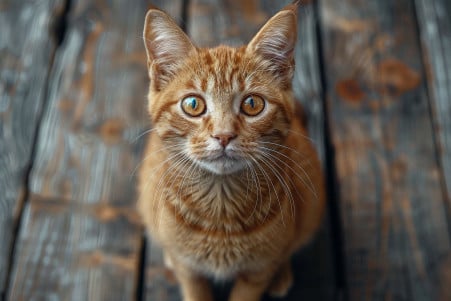Why Are Siamese Cats Mean? Debunking the Stereotypes and Truths
6 May 2024 • Updated 6 May 2024

Siamese cats are best known for their unique appearance and talkative nature, but their reputation for being mean or even aggressive is one of the most enduring stereotypes about this popular breed. In reality, Siamese cats are not meaner than other breeds, and their tendency to act out is more likely a result of their assertive nature and need for attention. When properly socialized and cared for, Siamese cats are loving and loyal pets.
To debunk the myth of the mean Siamese cat, we will look at scientific research on feline behavior and breed traits. By reviewing studies by animal behaviorists, veterinarians, and other experts on cats, we will learn more about the Siamese cat's unique personality and the best ways to raise and care for this intelligent breed. Armed with a better understanding of the factors that drive Siamese cat behavior, you can build a more fulfilling relationship with your cat.
Are Siamese cats mean?
Debunking the Myth: Are Siamese Cats Mean?
Siamese cats are known for being friendly, affectionate, and social with their human family members. Their talkative and demanding nature can sometimes lead to a misunderstanding that they are mean or aggressive. In reality, Siamese cats are generally sociable and no more or less aggressive than other breeds when they are socialized and cared for properly.
Aggression in cats can be caused by a number of things, including fear, stress, anxiety, and lack of enrichment. While some breeds may be more prone to certain behaviors, a cat's personality and behavior are largely shaped by their environment and experiences. This is why it's important to understand the underlying causes of aggression in order to address it with the right training, enrichment, and care.
Many aggressive behaviors can be avoided in Siamese cats by ensuring they are well-socialized, mentally stimulated, and living in a low-stress environment. Siamese cats' intelligence and love of people make them wonderful pets when their needs are met. Debunking the myth that Siamese cats are mean will help people better understand and enjoy this breed's special qualities.
How to Deal With Aggression in Siamese Cats
Although Siamese cats aren’t aggressive by nature, some cats may exhibit aggression due to a number of different reasons. PetMD explains that aggression in cats can be caused by frustration, lack of socialization, chronic stress, fear, or medical conditions like feline hyperesthesia syndrome.
To help your Siamese cat deal with aggression, it’s important to use positive reinforcement training, make sure your cat’s environment is stimulating, and make sure any medical issues are being treated. Holistapet suggests that you can also help your cat deal with aggression by making sure they have an outlet for their energy and using natural products like CBD, catnip, valerian root, and calming diffusers to help them feel less stressed and anxious.
If your Siamese cat’s aggression is extreme or doesn’t improve with these methods, you may need to work with a veterinary behaviorist to help your cat. Untamed explains that a veterinary behaviorist can help you figure out why your cat is aggressive and work with you to come up with a treatment plan that addresses the underlying cause of the aggression.
Once the cause of your Siamese cat’s aggression has been identified and treated, you can work with your cat to help them overcome their aggressive behaviors and build a strong, loving relationship.
How to Introduce a Siamese Cat to Other Pets
Siamese cats can be territorial and may not immediately accept new pets in the household. Purrtalk.com explains, this means that a long, drawn-out introduction is necessary to make sure that the new pet is accepted and that there are no issues. This should be done in three steps: separation, visual contact, and full contact, each of which should last for several weeks or even months.
Knowing the pets' personalities and making sure that they have their own space and resources can help to minimize stress and conflict. The Siamese Cat Rescue Center recommends that the new cat be isolated for 10 days before being introduced to the other cat. This way, they can get used to the other cat's scent and sounds before they meet them in person.
Omlet.com suggests that the first physical meeting between cats should be supervised and that hissing and running away is normal. It will take time, patience, and positive reinforcement to make sure that a Siamese cat and other pets can live together in harmony. However, it's definitely possible to make it work with a little patience and a lot of time.
Siamese Cat Health Issues and Breed-Specific Conditions
Siamese cats are known to be at risk for a number of genetic health problems, including respiratory issues, eye conditions, and gastrointestinal problems. International Cat Care lists some of the most common health issues as asthma, nystagmus (involuntary eye movement), progressive retinal atrophy, and amyloidosis (a condition where proteins are deposited in organs).
A healthy diet, regular exercise, and frequent vet visits are all important for catching and treating these issues early. Catster also notes that Siamese cats can also be at risk for a number of other health problems, including feline hyperesthesia syndrome, obesity, and dental issues.
In addition to responsible breeding and genetic testing, there are a number of other ways to prevent and manage the genetic health problems that Siamese cats are prone to. Integricare lists regular monitoring and weight management, the use of supplements, and prioritizing dental health as important factors in promoting the overall health and well-being of Siamese cats.
By staying on top of their cat’s health and understanding their unique needs, Siamese cat owners can ensure that their pets live long, healthy lives despite their genetic predisposition to certain health problems.
Conclusion: Understanding and Working With the Siamese Cat's Personality
The Siamese cat's personality is distinctive, and while this can be both rewarding and challenging for pet parents, with the right socialization, training, and care, their strong-willed nature and need for attention can lead to a loving and rewarding relationship. Understanding the breed's unique characteristics and addressing any potential health or behavioral issues is key to ensuring a happy and healthy life for a Siamese cat.
By dispelling myths and accepting the realities of the Siamese cat's personality, pet parents can form a close bond with this loyal and intelligent breed. With the right approach, consistency, and willingness to meet the Siamese cat's needs, pet parents can develop a strong and lasting relationship with their feline family member.


